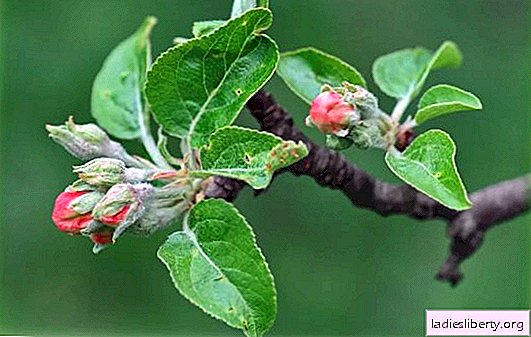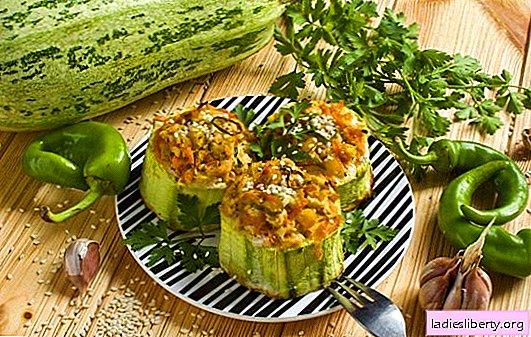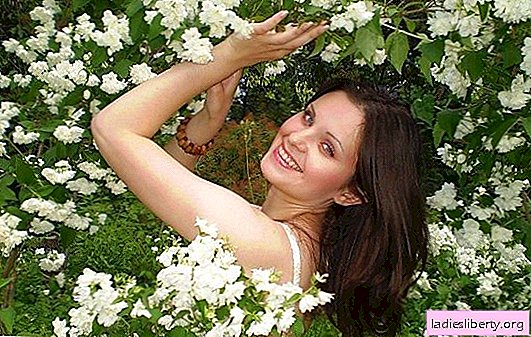
It's a shame when in the spring the apple tree stands with non-blooming buds or dries a couple of leaves when it dries out ....
Apple trees have not blossomed: what is the reason
Most fruit trees are harmed by low temperatures in winter (up to 35 - 40 degrees of frost), which persists for a long period, sudden changes in temperature, when the thaw gives way to unexpected cooling. In this case, the bark and the wood of the trunk of the apple tree may be damaged, especially flower buds. The possibility of death of annual shoots depends on the maturation of their wood. Growths with developed apical kidneys are damaged less. Shoots can ripen poorly due to high humidity and excess nitrogen in the soil.
In addition, during a drought in May, small apple trees may end growth too early. If it rains in July and August, the shoots can start to grow again, they do not have time to mature before frosts and can die in the winter. Damaged annual shoots are cut in the spring, cutting to healthy wood.

The level of damage to the wood of adult trees is determined by its color - slight freezing - light yellow, significant damage - dark brown. If the wood is badly damaged, then the branches and trunk become brittle and you can notice plaque on the bark similar to soot. The resistance of the affected trees to low temperatures is reduced, and under adverse conditions, sick apple trees can die.
Tree development is negatively affected and bark injury. Aging by the end of the season occurs from the periphery of the crown and continues to the stem. For this reason, in areas of the connection of branches, and in the area of the stem, tissue resistance to low temperatures is always worse. In these places, the bark first freezes. In early spring, the crust can be damaged by the bright rays of the sun, causing burns to it, which arise from the inhomogeneous heating of the bark and sudden changes in daily temperatures.
The injured bark is reddish or brown, after a while it will begin to die. After a summer or autumn drought, trees next spring are more damaged by burns. To reduce the risk of their occurrence on the bark, the trees are whitewashed in the autumn. For this purpose, freshly slaked lime (in a proportion of 2 kg of lime per bucket of water), with the addition of 1 kg of mullein or clay to the solution.
In adult trees, after severe frost damage, flowers do not appear from buds in spring. If the plant is not severely damaged, then the flowers may appear, sometimes the ovaries even grow, but their bulk will quickly fall. To protect trees from winter damage, they need to be well looked after - to protect the bases of skeletal branches and boles, with the help of snow, the slate forms are completely sprinkled with snow, to fight diseases and pests, trim the crown in time, fertilize plants and irrigate.
In the spring, the apple tree did not blossom: what can be done
In winter, mostly groomed stanzas and standard trees are mostly damaged. Low-cut stlanes, the crown of which can hide under the snow, do not suffer from frost in cold winters. Pruning of damaged adults: trees, transferred to the first decade of summer, after their growing area is formed. Injured branches are cut off near the place of formation of new shoots.
Trees on which leaves grow only at the ends of branches, and the buds below are dead, need to be well fed so that new shoots can form from sleeping buds. For faster recovery of affected trees, their it is necessary to cut in the spring in areas of vigorous growth of new shoots.
With significant damage to the crown of the tree, and the appearance of new shoots only near the stem, the tree can only be restored from the cultivated shoots growing above the vaccination site. The injured crown is cut off "on a stump", and from the shoots that have appeared, using a trim, create a new one. Each of the shoots needs to be oriented vertically, forming a conductor from it, new growths accelerate the retraction of a large wound that appeared when cutting a shrunken crown.
If the tree died completely, and the shoots grow directly from the stock, then it is necessary to produce inoculation with a suitable apple variety, and a new tree will grow on old roots. The most developed shoot is chosen, the rest are cut out or simply shortened to allow the left wild game to develop well and provide nutrition to the roots. Varieties of apple trees zoned in this area develop faster and five years after vaccination are able to bring a small crop of apples. With significant damage to the trees with the need to cut ½ and a larger share of the crown, they can not be tried to be restored, but another apple tree planted. If the main reason for the death of the plant is an unsuitable place for planting (a lowered area where cold air gathers), then it makes no sense to restore or plant a new tree.
Protection of apple trees from frost
A strong drop in temperature during the flowering of the apple tree can not only significantly reduce the yield, but also can completely destroy it. A temperature dropping to 2 degrees below zero is fatal for blossoming inflorescences.
Heavily frostbitten flowers and ovaries quickly fall, and from not very damaged, clumsy fruits grow. If the temperature decrease is short-lived, with a decrease in temperature to 1.0-1.5 degrees of frost, then the standard trees can not be affected. They only have a natural removal of excess flowers, which will not reduce the overall yield. Most dangerous for the apple tree is returning cold, at which the temperature drops significantly, and this is accompanied by strong gusts of wind, and all flowers can die.

To protect against frost, you can use it in quiet weather smoke bumps or smoke using a bonfire. In strong winds, smoke use is greatly reduced.
With a short decrease in temperature, sprinkling and irrigation of the soil, which produce up to 2 degrees of heat when cooling, helps well. Near the surface of the soil, sometimes a strong decrease in temperature is observed. For this reason, the yield on the stlanes can be severely affected by frosts, and you can reduce the risk of damage by using the following operations:
1. Stlanza is best planted on elevations, where cold air is not collected, but low places move;
2. During the flowering of stanzed varieties, they can be covered with plastic wrap or several layers of burlap. It is necessary to cover plants in such a way that cold air cannot penetrate under your shelter. Trees need to be sheltered in the evening, and in the morning they remove the protection against frost;
3. Remember that on the branches of the stalans raised above the soil, inflorescences form later than on the lowered ones, you can raise the tree crowns with stakes or poles, you need to raise them to a height of 30 - 40 cm;
4. Regular trimming of the crown, improves air circulation inside the crown. This is important because honey with dense thickets of branches increases the risk of damage to the tree during frosts.











